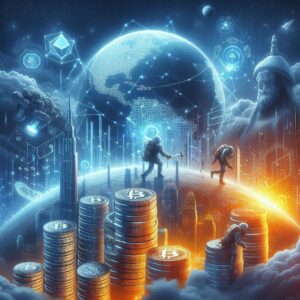Non-Fungible Tokens (NFTs) are unique digital assets stored on a blockchain. Unlike cryptocurrencies such as Bitcoin or Ethereum, which are fungible and can be exchanged on a one-to-one basis, NFTs represent ownership of a specific item or piece of content and cannot be directly exchanged for one another. NFTs are primarily used to prove authenticity and ownership of digital or physical items such as artwork, music, videos, or collectibles.
The value of NFTs is determined by their rarity, desirability, and the demand for the underlying asset. They have gained significant attention in recent years, especially within the art and gaming industries, where digital ownership and exclusivity are highly valued.
How Do NFTs Work?
NFTs are typically created using blockchain technology, with Ethereum being the most common platform. The blockchain serves as a decentralized ledger that records each transaction and ensures the token’s uniqueness.
- Smart contracts: NFTs rely on smart contracts, which are self-executing agreements encoded directly into the blockchain. These contracts define the NFT’s characteristics, such as ownership rights, transferability, and royalties for the creator.
- Token standards: NFTs follow specific standards, such as ERC-721 or ERC-1155 on Ethereum, ensuring compatibility across various platforms and applications.
- Minting process: The creation of an NFT, known as “minting,” involves converting a digital file into a token and registering it on the blockchain. Once minted, the NFT can be bought, sold, or traded on marketplaces.
Use Cases and Benefits of NFTs
NFTs have a wide range of applications, offering both creative and practical benefits. Some popular use cases include:
- Digital art: Artists can monetize their work by selling NFTs that represent ownership and originality.
- Gaming: NFTs are used for in-game items, such as characters, weapons, or skins, allowing players to own and trade assets across games.
- Music and entertainment: Musicians and creators can release exclusive content as NFTs, providing new revenue streams and direct engagement with fans.
- Collectibles: Digital trading cards, sports memorabilia, and other unique items are increasingly sold as NFTs.
- Virtual real estate: NFTs are used to represent ownership of virtual land in metaverses.
- Proof of ownership: NFTs serve as certificates for real-world assets, like real estate or luxury goods.
NFTs have revolutionized the way ownership is defined and exchanged in the digital world, opening up new possibilities for creators and consumers alike. However, their volatility and environmental impact remain areas of concern.



